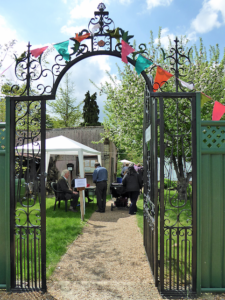September 2020
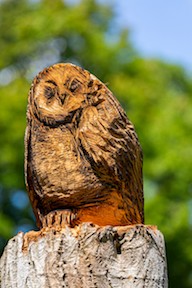
It has been a delight to see so many people using the garden during the past few months to meet up with friends and family, as the Covid-19 situation limits the opportunities for travelling further afield. As well as our regular visitors, we have also welcomed many new faces to the garden. As one of them commented recently, it really is a hidden treasure in the centre of the village. If you haven’t been to the garden yet, please do drop by to see for yourself. There are lots of different areas and plantings to view, with plenty of seats and benches to rest on. Always something new to see or to revisit favourite parts, or to find a quiet spot to read or chat.
We are pleased too that some local groups have been using the garden for various activities or to hold meetings, as their usual meetings places are still closed. There are regular sessions of tai chi, Pilates, sketching and painting, and the Sawston Steel Pan Band have been practising here. The Royal British Legion, Women’s Institute and Sing to Remember also hold regular meetings and social gatherings. More recently, Cambridge Rare Diseases Network – a support group for families affected by a range of very rare conditions – have met in the garden. They had had great difficulty sourcing venues for outdoor activities and have been delighted to ‘find’ the Challis Garden.
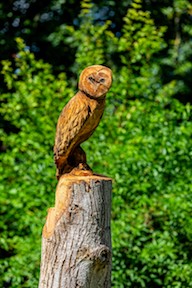
In view of the ongoing Covid situation and the recently announced restrictions limiting meetings to a maximum of six people, we ask visitors to respect these guidelines when using the garden. There are notices on each table to remind everyone to keep to the ‘Group of Six’ rule and to use the hand sanitisers. Thank you for your cooperation.
It is disappointing that we haven’t been able to hold any events this year, and have now decided to cancel our popular Spooky Saturday Hallowe’en event. Under the circumstances, it would be impossible to maintain social distancing and maximal group sizes, given the nature of the usual activities and lots of excited children. A great pity, but we feel it is the right decision.
Our ‘Name the Owls’ competition has attracted lots of entries so far. We hope to get more entries from children once they receive their entry forms at school. A shortlist of names will be selected for a public vote and the winners will be invited to a small socially distanced naming ceremony, most probably on 31st October. Good luck to everyone who enters. If you haven’t seen our owls yet, do come and have a look to see what the fuss is all about!
The garden has benefitted from an upsurge in volunteer numbers as well as visitors in recent months. Many new volunteers have offered their time to help in the garden, for which we say a very big thank you. This has enabled us to keep up with garden maintenance and also to tackle a few long-outstanding tasks. And there’s always more to do!
Like everyone else, we have had bountiful crops of fruit this year – especially our plums, gages, damsons and apples. Andy Jackson (of ‘Andy’s Allotment’) has excelled himself making record quantities of a variety of jams and chutneys, using produce from the garden. In early September we processed some of the apples from our own trees and donated fruit to produce sixty bottles of apple juice. Many thanks to those people who brought apples for juicing. We’ll have another session later in the autumn.
The herbaceous borders are looking good: lots of colour with asters, penstemons, dahlias, begonias and zinnias, which should last well into October. With the autumn fast approaching, we are now looking towards cutting back perennials that have finished flowering and reducing overgrown clumps.
For those of you looking to renovate borders or starting new gardens, please do have a look at our stock of plants for sale. There is always a wide choice of planting material available – have a look, you might well find what you need for that gap or replacement, or to introduce something new. This year, we also have two-year old semi-standard ‘Mary Challis’ apple trees for sale. These are unique to our garden and can’t be purchased elsewhere. A cross between Cox’s Orange Pippin and Dr Harvey (an old English cooking apple), it has been accepted as a unique variety and listed on the Register of Local Cultivars. It produces large apples, with very good cooking properties but sweet enough to be eaten raw. If you are interested, please contact us to reserve a tree.
We also have two-year-old golden rain trees Koelreuteria paniculata for sale. Also known as Pride of India, these are handsome trees, up to 10m tall, that produce striking pinkish-red foliage in spring and masses of yellow blooms in June–July that develop into bladder-like seed capsules in the autumn. A great specimen if you have the space, though the size can be controlled by pruning.
We would like to acknowledge and thank the Royal British Legion for a generous donation, sourced from the Central Co-op, for which we are very grateful. This has been used to purchase a much-needed log-splitter and some ornaments for our ‘chicken shed’ exhibit.
The Challis House and Museum remains closed for the foreseeable future and is unlikely to open again until next year. However, a visit to the library and archives for research purposes can be booked by appointment.
Mike Redshaw
Published in Sawston Scene, October–November 2020 – see page 17 for a feature on groups meeting in the Challis Garden.
Read MoreJuly 2020
The garden was understandably closed to visitors during the lockdown for several weeks. Since re-opening in the second week of June, we have rarely been so busy. It is wonderful now to see lots of visitors enjoying the garden as a safe and peaceful haven to meet up with friends and family. At the time of writing, the museum and the archives are still closed and we do not anticipate opening any time soon. Our Easter event in April and the Anniversary Fete in May were cancelled, but we were able to open for the National Garden Scheme on 28th June and 5th July. However, we have decided to cancel all other events for 2020, including the Horticultural Show.
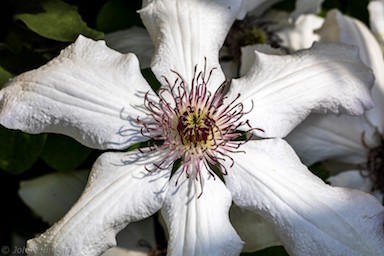
The Challis Trust has supported the National Garden Scheme since the garden was first opened to the public in 2009. We were somewhat surprised, but delighted, at the annual meeting of the Cambridgeshire NGS group, to be awarded an inscribed trowel in recognition of opening the garden for ten consecutive years. As you are probably aware, the NGS raises money from garden openings, such as ours, to raise money for key nursing and caring charities, including Macmillan Cancer Support, Marie Curie, Hospice UK, Carers Trust, Queen’s Nursing Institute, Parkinson’s UK, Perennial and many others. This is especially pertinent at the present time, with many of these organisations on the front line in the fight against coronavirus. They need our money more than ever before. Our two open days raised around £700 for the NGS, so thank you to everyone who supported the Open Garden events.

The NGS has donated around £3 million pounds annually in recent years, but it estimates its income will be down by 80% this year due to the lockdown. This amounts to a huge shortfall in funding for many of the charities it supports. If you have been affected by the pandemic or have experience of any of these charities, please consider making a donation to the NGS in lieu of visiting a garden this year, to enable it to continue to support these important charities. You can watch some virtual garden tours online at www.ngs.org.uk and make a donation there.
We managed to continue basic maintenance in the garden through the lockdown. The garden is looking very good now; it is such a pity that visitors could not see it in spring and early summer. There were very good displays of spring flowers through February to April, but the exceptional hot and dry conditions in April put an early end to these. Early-flowering summer shrubs and trees put on good shows, notably Laburnum, Philadelphus and lilacs. In the herbaceous borders, irises, peonies, penstemons and geraniums all blossomed well. ‘Gaps’ in these plantings have now been filled with colourful annuals raised in our glasshouses, including begonias, zinnias, cornflowers, pelargoniums, salvias and rudbeckias. The wildflower meadow in the centre of the main lawn is at its best now. Lots of colour to come in the summer months!
There is a good stock of plants in our nursery. Annuals, herbaceous perennials, grasses, alpines and some shrubs and trees are all available. We also expect to sell half-standard two-year old ‘Mary Challis’ apple trees in the autumn. There is limited stock, so please let us know if you would like us to reserve one for you.
Very sadly, an old walnut tree died earlier this year and had to be removed. However, it will be given a new lease of life by the woodcarver Ben Hayford, who created ‘Gerry the giraffe’ next to Merlin Mica’s store. The carving should be completed by the time you read this. Do come and have a look at the new incarnation.
I’m sure the wildlife in the garden benefitted from the peace and quiet of the lockdown. The spring birdsong was delightful this year, with goldcrests, goldfinches, chaffinches, blackcaps, thrushes, robins and wrens singing throughout the day. In the winter, a single red-legged partridge was present but has since moved on and been replaced by a male pheasant – a very colourful addition. Hedgehogs are also often seen. For those of you interested in birds, from 2017 we’ve compiled a list of birds seen in or from the garden, and in May reached the milestone of fifty species – not bad for a semi-suburban setting. The fiftieth record was something of a surprise – a pair of common terns passing overhead. These birds are almost certainly part of the small colony breeding at Dernford Reservoir. It is surprising what there is to see if you stay alert to the sounds and sights around you.
All three of our beehives are occupied this year and developing well. The two flow hives received swarms collected locally in 2019 and came through the winter intact. A first small harvest of honey was extracted from one of these hives in early May, giving a mixture of comb honey and set honey. The prospects for the summer harvest are promising. Fingers crossed!
For obvious reasons, there is no activity in the Challis house at present or for the foreseeable future, so little to report on in the museum and archives. Our team of archivists are keen to resume their work sorting and cataloguing materials and artefacts. Planned exhibitions are on hold but will be set up as soon as circumstances allow. As they say ‘watch this space’. Meanwhile, stay alert and stay safe. Mike Redshaw
Published in Sawston Scene, June–September 2020
Read MoreMarch 2020
For this special fiftieth anniversary issue, it has been fascinating to look back at articles about the Challis Trust going way back to its inception. Sawston Scene has always been very supportive of the trust, providing a platform for reporting progress in the house and garden, and publicising our events and exhibitions. Regular visitors will know much of the background but it is well worth relating it again.
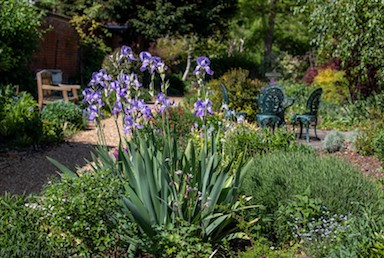
A brief history of the Challis family in Sawston appeared in the February–March 2014 issue:
“The first Challis to settle in Sawston was Thomas Challis (1754–1816). He was a farmer, co-founder of the Congregational Church, and the father of ten children. One of his sons, Johnathon, married a daughter of James Everard of Pampisford and received a property in Sawston known as Monk’s Orchard from his father-in-law. It was his son, Arthur James, who developed the orchard, now the Mary Challis Garden, and built the family house at 68 High Street in about 1850. He was Mary Challis’s grandfather and he and his son Alfred were auctioneers and clerks to the Parish Council.
Mary was the fifth generation of her branch of the Challis family to live in Sawston. She lived here all her life except for the short time she spent at Studley College for Women, in Warwickshire, where she took a BSc in Horticulture. She never married and, when she died in 2006, she had no close relatives and chose to leave her house and garden in trust ‘for the benefit of the inhabitants of Sawston and the neighbourhood.’ For this, we are profoundly grateful.”

The A M Challis Trust was established in 2007, following a preliminary meeting of volunteers early that year (reported in Sawston Scene April–May 2007) and they began the daunting task of restoration. The very overgrown garden was gradually cleaned up, trees felled, fences repaired, new beds laid out and old buildings removed – a huge achievement – leading up to the formal opening in May 2009 (August–September 2009). Today, it is unrecognisable from earlier photos. A special mention must be made of the immense contribution of Sue and Ray Reeve, who were instrumental in getting that early group of volunteers together to begin work on the garden. They are sorely missed and fondly remembered by all who worked with them.
The trust depends almost entirely on the rental income from its three properties on the High Street and welcome donations from visitors. This money has been used to renovate the Challis House, an undertaking that continued for nearly a decade! In the early years, there were serious concerns about the financial position of the trust, to the extent that consideration was given to leasing the property to a developer, to convert the upper two floors to flats (Scene June–July 2009). Fortunately, this did not happen and the trust retained full control of the house, which has now been restored to a high standard and includes a Museum of Sawston as Mary Challis wished. Several exhibitions have been held, including the current one ‘Half a Pound of Tuppenny Rice…’ focusing on co-operative societies and shopping in Sawston over the years, and more are lined up for the future, although due to the coronavirus the museum is currently closed.
It is planned to hold an exhibition of old toys and games (up to the 1960s) later in the year. If you have anything of interest to lend or donate for this – Victorian dolls house furniture, metal animals, puzzles, games, Meccano and suchlike – please get in touch.
We had planned an exhibition about Sawston Scene in April–May to commemorate their fiftieth anniversary. The current plan is that some of the articles from the archive that would have been displayed will instead be printed in the June–July 2020 issue. There have been regular reports on the trust in nearly every issue of Sawston Scene since 2009, written by either Sheila Blackwell or Marilyn Maunder up to 2015, then by myself from 2016. These reports give an excellent account of developments accompanied by numerous photos of the garden and our events. We were especially pleased that the front cover of the first colour edition in April–May 2012 featured an image of the garden.
The trustees congratulate Sawston Scene on achieving fifty years of regular publications for the village and for the many awards it has won over the years for the quality of its content and editorial standards. Well done! We hope to continue our positive relationship with the magazine for many years to come.
Spring is rapidly approaching, with spring-flowering shrubs and bulbs coming into bloom early in the garden. Daffodils are looking good now, and should last into April, followed by tulips and early summer herbaceous plants. It’s a good time to visit. We shall soon be committed to regular grass-cutting and setting up for garden events.
Neither our popular Easter Saturday Children’s Event nor our Anniversary Fete scheduled for Sunday 17th May will be held this year due to the coronavirus pandemic. We deeply regret having to take this action but it is for the benefit of all our visitors and volunteers. Sunday opening times will revert to 2pm to 4pm from Sunday 29th March when the clocks change to British Summer Time. Mike Redshaw
Published in the April–May 2020 Sawston Scene
Read MoreThe Challis Museum is closed until further notice
Today, I took the difficult decision to close the Museum to visitors. This was not something I did lightly but came in the wake of ever-increasing draconian measures being imposed by the government.
You may feel that an exhibition with only a relatively small number of visitors at any one time is a very low-risk situation but if it being open results in the illness of even one visitor, Steward or Trustee, it is a risk too great to contemplate. As the days go by, I will review official advice with a view to possibly re-opening but for now the doors stay firmly shut.
Let us look on the positive side and give thanks for the fact that the exhibition has been open since the middle of January. Just imagine – the virus might well have erupted back then before anyone had had a chance to see it! As it is, we should be proud of what we have been able to share with our visitors and allow ourselves at least a small pat on the back when we read the lovely comments left in the Visitors’ Book.
Mary Dicken has made a wise decision to put her Tuesday Archive Group on hold until at least after Easter and I am now going to do the same for the Monday Exhibition Group. Both these activities will resume at the earliest safest moment and in the meantime, neither group is involved in work that cannot easily be suspended.
We have had to consider carefully upcoming Challis events and feel that we had no choice other than to cancel the Children’s Easter Event. No need to explain why – face painting/craft workshops/teas/toilets! Need I say more?
Most of our booked visiting groups come to see both the House and the Garden and we always offer refreshments too. Unfortunately, most of these groups also fall into the most vulnerable/susceptible demographic and as such, I have already cancelled two bookings for this coming week. I will continue to deal with upcoming visits on a group by group basis.
Other Challis events are currently scheduled to go ahead as planned but you will understand that that this might well change.
What this state of affairs will not do is anything more than ‘dent’ the Trust. The Garden remains open to visitors – a really healthy place to be(!) and everything else is simply on hold in a virtual pending tray. Unlike some small businesses, we will not be going under financially because of this and when the crisis has finally passed, we will do our level best to reschedule as many cancelled events and group visits as possible.
Remember – you are not now isolated from the Trust. I am here at the end of this email and on 560816 and 07711 332129 at any time.
Stay safe.
Warm wishes
Rosie Phillips
Chair of the Challis Trust
January 2020
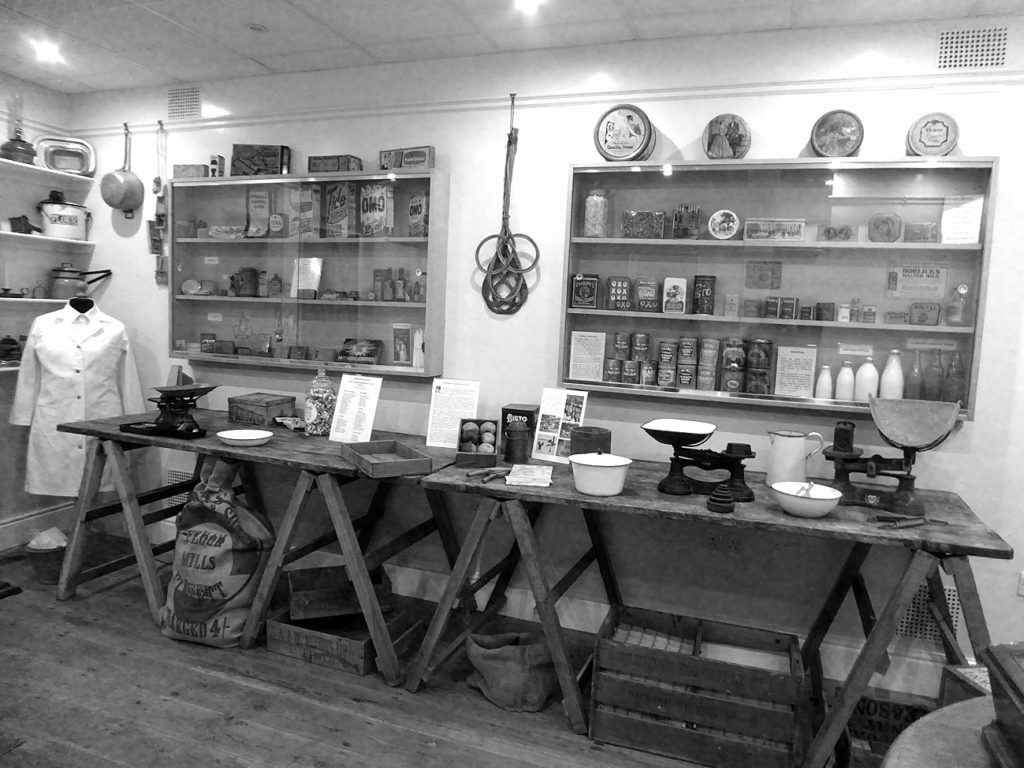
At the time of writing, the Challis museum and archive team are in the throes of finalising the displays for our latest exhibition ‘Half a Pound of Tuppenny Rice…’ about the co-operative movement and shopping in Sawston. It includes some activities for children. Despite concerns that we didn’t have enough items to re-create an early 1900s shop, villagers have turned up trumps and donated lots of interesting objects to put on display, for which we are very grateful. The exhibition runs until 28th March and is open every Tuesday and Saturday morning from 10am to 12 noon. Do drop in to have a look at the exhibits and chat with our knowledgeable stewards. ‘Pop goes the weasel’!
The unseasonably mild weather – or perhaps this is now the new norm? – has encouraged spring bulbs to flower earlier than usual. There are already many snowdrops and a few aconites in flower. These should be at their best through February into March, followed by crocuses and then the daffodils around Easter time. These displays are a joy to see, especially on sunny spring days. Do pop in to the garden to have a look. The winter/spring border is also looking good now. Hellebores are starting to flower, set among a colourful display of lime-green, red, orange and yellow stems of dogwoods (Cornus spp.). Winter-flowering shrubs – notably sweet box, Mahonia, shrub honeysuckles and Viburnum fragrans – are giving off pulses of delightful scents to attract pollinating insects. Hmmm!
It is a relatively quiet time in the garden, but there are always jobs to be done. Maintenance of the garden is well up to date and always to a good standard, thanks to the regular volunteers who look after it. The Challis Trust relies entirely on voluntary work for all that it does, and we are hugely grateful for the time put in, and also to the many regular visitors who support our work.
In recent weeks, we have been tidying up overgrown areas, trimming ivy, pruning shrubs and cutting back overcrowded perennials. Judy has been busy as ever propagating some of our most popular perennials, for sale later in the year. If you are looking for interesting or unusual plants for your garden, do come along to see what’s on offer.
The next large task is to prune the apple trees while they are dormant during the winter months. We plan to produce more bud-grafted apple trees, using budwood from our Mary Challis apple. Last year, we used MM106 semi-vigorous rootstocks, which are suitable for bushes and half-standard trees. This time we will use M26 semi-dwarf rootstocks, to produce plants suitable for small bushes, cordons, fans and espaliers. Last year’s stock will be available for sale this summer and autumn.
A few more sycamores are scheduled for removal this winter to reduce over-shading in parts of the garden. This includes the large sycamore at the end of the Long Barn – a lovely specimen, but unfortunately the trunk is badly diseased and therefore hazardous. However, this will generate good quantities of timber for making logs. Currently, we have a mixture of sycamore, ash and chestnut logs available. We have made good sales of logs this winter and may well have to re-stock soon from a local source. Do collect your logs now to avoid missing out!
It is disappointing to report that there has been no further progress on building work for the garden museum, pending approval from the SCDC Planning Officer. We sincerely hope to make a start soon with a view to completing the building during 2020.
The programme of Challis events for 2020 is printed on page 2 of the February–March 2020 Sawston Scene – we look forward to seeing many of you in the garden during the forthcoming season. Remember the garden is open every Tuesday, Thursday and Saturday morning from 9.30am to 12.30pm, and on Sunday afternoons (1pm to 3pm in the winter and 2pm to 4pm in the summer). In addition the Challis House is open every Tuesday morning from 10am to 12 noon to view the museum and archives.
Mike Redshaw
Published in the February–March 2020 issue of Sawston Scene
Read MoreNovember 2019
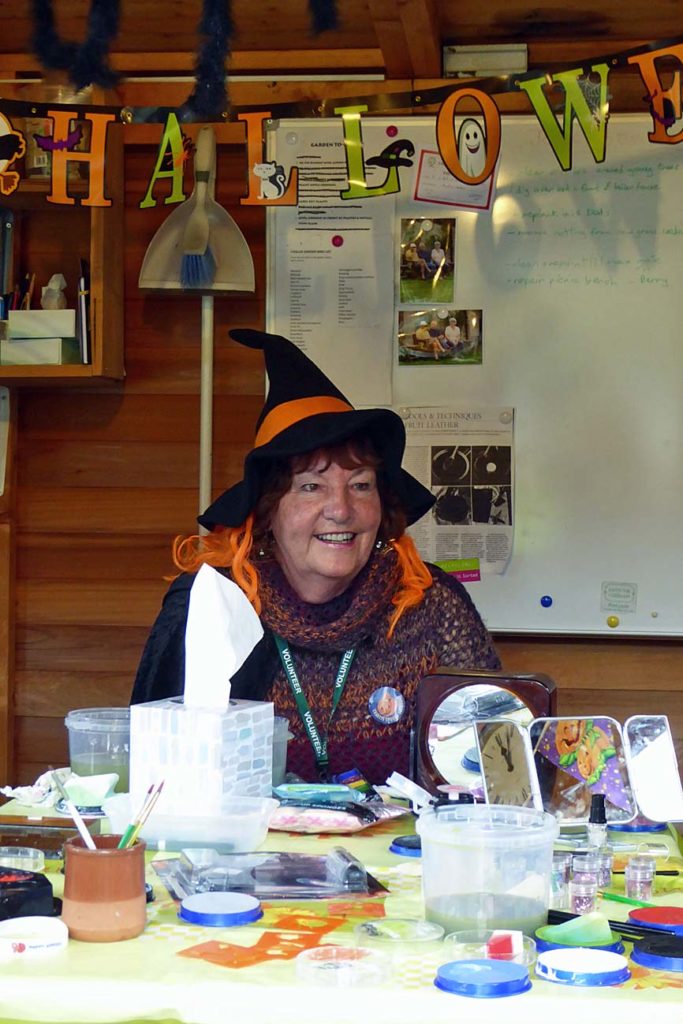
Our Spooky Saturday event on Saturday 26th October again proved to be very popular with villagers. It was wonderful this year to see many new families coming to enjoy a happy and fun morning in the garden in good autumn weather – mild but windy. I suspect many more people would have joined us were it not for England’s Rugby World Cup semi-final match that morning! In the event, more than forty pumpkins were carved and taken home for Hallowe’en. Many thanks to the volunteers for helping with the carving, face-painting, crafts, scavenger hunt, soup kitchen and teas. Unfortunately for us, a tent we put up for the pumpkin carving was ripped out of the ground and blown over the chicken sheds by very strong gusts during the night. It will have to be replaced next year. On the upside, England won their match!
This was our last event for 2019. Please note that we will not be holding a wreath-making workshop this year, but the Challis House will open for the Winter Fair on Friday 6th December, so do please drop in to say hello and share some mulled wine and mince pies. It’s also a good opportunity to pick up some Christmas presents from the craft stands in the house. We will also have our very own Challis tea towels on offer, with a beautiful house and garden design by Fran Godwood.
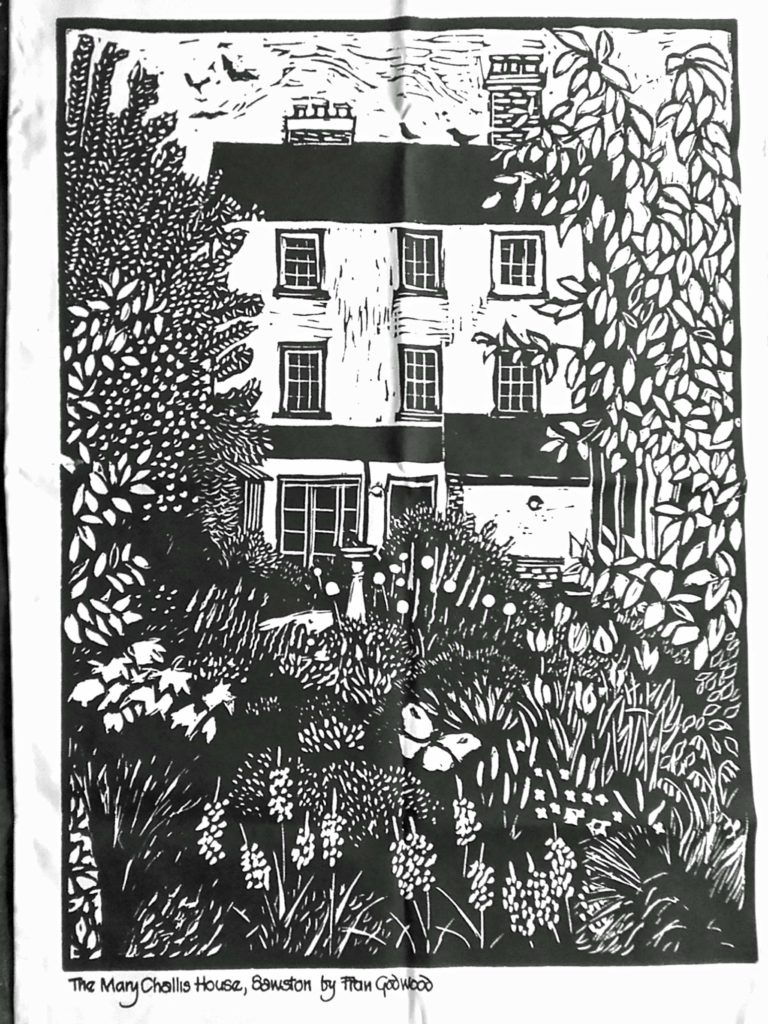
The mild autumn – so far! – has extended the flowering season well into November. Some dahlias were scorched by ground frosts in late October, but there is still a lot of colour in the main herbaceous beds, notably asters, Gaura, penstemons, sedums and salvias. Gaura is an interesting addition to our flowerbeds, a low-maintenance, hardy plant that flowers throughout summer and autumn. A good ‘doer’, as Monty Don would say. The full botanical name is Gaura lindheimeri, originating from North America, also called wandflower, whirling butterfly or bee blossom. The variety we have is ‘Passionate Rainbow’, producing numerous delicate pretty pink flowers on waving ‘wands’. We have taken many cuttings to propagate stock for next season.
The garden volunteers have been very busy preparing for winter – collecting leaves, spreading leaf mulch on the winter/spring border, digging over the vegetable beds, pruning shrubs, and so on. There is always plenty to do at this time of the year. We received some very welcome help for some of this work from a group of volunteers from Astra Zeneca, based at Chesterford Park. It was a productive and fun day, helping us to catch up with some outstanding tasks. Community volunteering is becoming increasingly popular; we have hosted two groups this year, and look forward to more groups in the future. Many thanks to the Astra Zeneca team for volunteering their time for us.
There is no progress to report, sadly, on the proposed building for a garden museum. We are still awaiting approval from the planning authorities, which is taking an inordinate amount of time. It was hoped to make a start on ground works before winter but this now seems unlikely. Meanwhile, we are progressing with identifying artefacts to go into the museum. The next step is to clean, prepare and label items – no small matter!
Our museum and archive volunteers continue to work through the archive material and artefacts in the house, with a regular Tuesday morning session. The house is open at this time, so if you want to have a look around and talk to our stewards, this is the time to visit. One team is preparing material for our next exhibition on shopping and Co-operative Societies, planned to run from 18th January to 28th March in the New Year. One of the first co-operative societies in England started in Sawston in 1867 and the Co-op itself has maintained a presence in the village for over a hundred years. It makes an interesting subject for an exhibition, with a lot of local interest.
Mike Redshaw
Published in the December 2019–January 2020 issue of Sawston Scene
Read More

